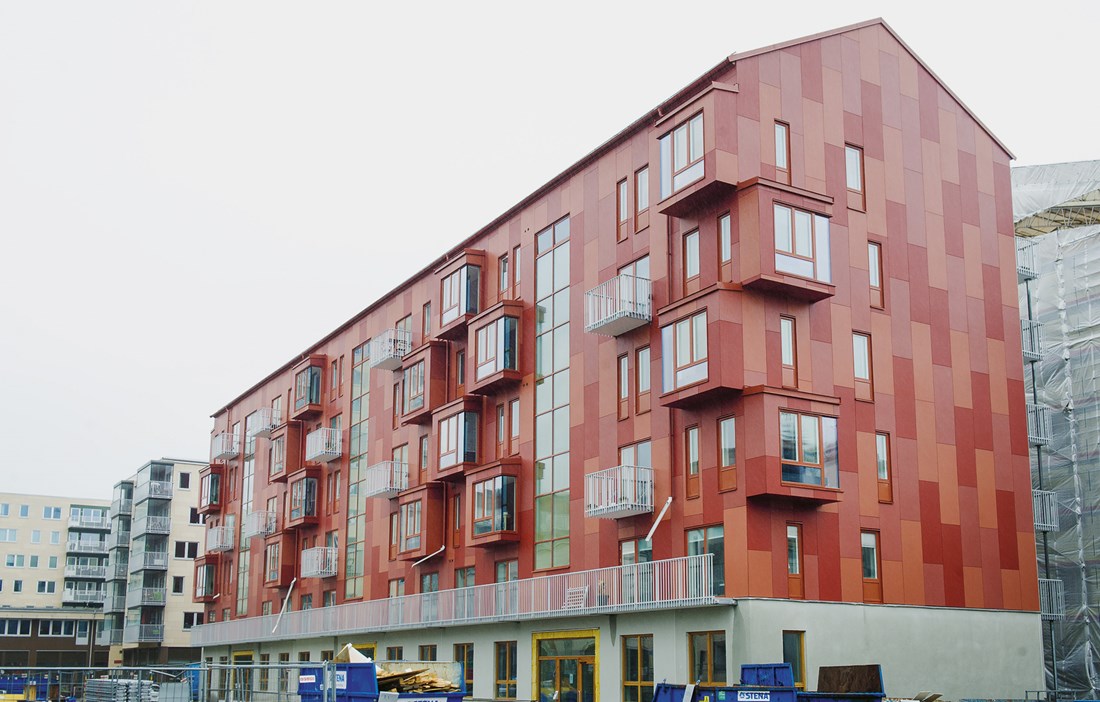Multi-storey buildings in wood are on the rise in Sweden as their many advantages become clear. The buildings have no drying times and are quick to construct, which reduces costs and generates less disruption for neighbours. Since the structural frame is light compared with other materials, laying the foundations is also easier.
Multi-storey buildings in wood have environmental benefits too, since the construction phase has a carbon footprint that is something in the order of 50 percent lower than with other materials. And then there is the working environment during the construction period, which is ergonomically good and pleasant. Of the companies operating in the market today, Lindbäcks Bygg, Moelven and Martinsons have perhaps come furthest in development terms, but Derome is also forging ahead.
Derome’s development of a concept for multi-storey buildings in wood over the years 2003–2014 has been put under the microscope. The study formed part of a research project at Halmstad University which examined the capacity for innovation among construction material manufacturers, amongst other things. The purpose of the study was to identify the factors that affect the uptake of wood construction for multi-storey buildings.
Completed projects and development work between construction projects were studied through interviews, reviews of documents such as plans and minutes from meetings, plus detailed observations of the most recently completed project, Trädriket in Gothenburg. External people with experience of multi-storey buildings in wood, both builders and clients, were also interviewed.
Factors that affect uptake
Since the way of building is relatively new, there is a need to create a new tradition compared with other building methods. According to the study, it is important to get people to recognise multi-storey buildings in wood as a reliable and economically viable method of construction. Presenting completed buildings as examples of best practice can also help to convince the sceptics, who believe that multi-storey buildings in wood would be worse than buildings constructed using other methods. The uptake of building in wood could be made easier if there were more people who were aware of and knowledgeable about this building method, since it would reduce any “start-up threshold”. In addition, the study shows the importance of working up well-defined construction systems with tried and tested solutions that ensure an effective construction process. The project that was studied in detail is a prime example of how easy it is to learn to build multi-storey buildings in wood – since there are major similarities with prefabricated family houses. The fact that wooden buildings are an eco-friendly alternative has influenced political decisions on housebuilding, which in turn has had a positive effect on the uptake of the method. External interviews in particular point out that wood is a safe and quick building method with few budget and planning deviations, as long as the system is well defined.
Developing a well-defined and smoothly functioning construction system requires a certain amount of financial endurance. The system itself is not complicated; the challenge lies in managing all the different parts of the system and quality assuring developments. The study shows that it is therefore important to complete more real-life construction projects, since it is in these that the developed solutions are fully tested and new stages of development are identified based on measurements and tests. An overview of developments shows, however, that many systems have become more complete over time, with the intermediary solutions agreed for the system making management and control easier.
Practical tips and advice
The shape and structure are often established early on, and this is usually combined with a great deal of prefabrication. It is therefore crucial to understand this and be active from the beginning of the process to have your voice heard. Once the production is underway, the opportunities to make changes become more limited. Where architects and structural engineers have a good understanding of the system and its intricacies, they have greater opportunities to produce solutions that ensure an efficient and competitive construction process. Factors that may affect the result include:
» The floor structure of multi-storey buildings in wood is often thick at 400–500 millimetres. This means that buildings can be somewhat higher than is traditional, although thinner wood hybrid systems are beginning to appear on the market.
» To achieve good acoustics and low sound values, it is important to follow the assembly instructions provided. Incorrect screwing can, for example, have a negative effect on the building’s acoustics. It is important to inform the people involved, particularly the tradesmen.
» There are wooden façades that are just as good as rendered façades in terms of maintenance. Using such an option may be of interest as a way to emphasise that a building has a wooden structural frame.
With the advances that we are seeing, the benefits on offer and the potential for continued growth, multi-storey buildings in wood are facing a bright future.
The study Diffusion of a systemic innovation was written by J. Lindgren and S. Emmitt. Read it in Construction Innovation 17, no. 1, pages 25–44.
TEXT John Lindgren





















